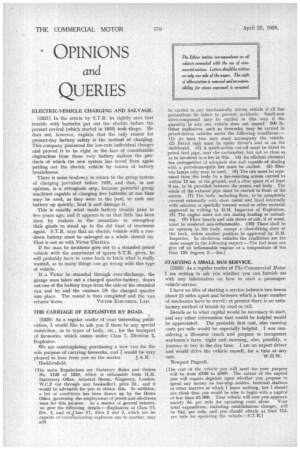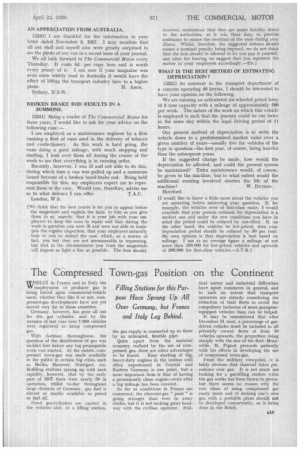OPINIONS
Page 56

Page 57

If you've noticed an error in this article please click here to report it so we can fix it.
and
QUERIES
153271 In the article by S.T.R. he rightly says that trouble with batteries put out the electric before the present revival (which started in 1933) took shape. He does not, however, explain that the only reason for present-day battery safety is the method of charging. This company pioneered the low-rate individual charger and proved it to be right in the face of considerable obatruction from those very battery makers the products of which the new system has saved from again putting out the electric vehicle by reason of battery breakdowns.
There is some tendency to return to the group system of charging prevalent before 1933, and that, in our opinion, is a retrograde step, because powerful group niacin'nes capable of charging five batteries at one time may, be used, as they were in the past, to rush one battery up quickly, heat it and damage it.
This is exactly what made battery trouble prior to five years ago, and it appears to us that little has been done by makers in the meantime to strengthen their goods to stand up to the old kind of treatment again. S.T.R. says that an electric vehicle with a rundown battery must be salvaged as a whole (towed in). That is not so with Victor Electrics.
If the man he mentions goes out to a stranded petrol vehicle with the assortment of spares S.T.R. gives, he will probably have to come back to fetch what is really wanted, as so many things can go wrong with this type of vehicle.
If a Victor be stranded through over-discharge, the garage man takes out a charged quarter-battery, draws out one of the battery trays froni the side of the stranded van and he and the vanman lift the charged quarter into place. The round is then completed and the van returns home. VICTOR ELECTRICS, LTD.
THE CARRIAGE OF EXPLOSIVES BY ROAD.
153281 As a regular reader of your inteiesting publication, I would like to ask you if there be any special restriction, as to types of body, etc., for the transport of fireworks, which conies under Class 7, Division 2, Explosive.
We are contemplating purchasing a new van for the sole purpose of carrying fireworks, and I would be very pleased to hear from you on the matter. J.A.K. Huddersfield.
[The main Regulations are Statutory Rules and Orders No. 1129 of 1924, which is obtainable from HAI. Stationery Office, Adastral House. Kingsway, London. W.C.2 (or through any bookseller), price 2d., and it would be advisable for you to obtain this. In addition, a list of conditions has been drawn up by the Home Office, governing the employment of petrol and oil-driven vans for this purpose. As a matter of general interest, we give the following details :—Explosives of Class VI, Div. 1, and of ‘Class VI, Dive 2 and 3, which are incapable of communicating explosion one to another, may H1S be carried in any mechanically driven vehicle if all due precautions be taken to prevent accidents. Small-arm nitro-compound may be carried in this way if the quantity in any one vehicle does not exceed rko lb. Other explosives, such as fireworks, may be carried in petrol-driven vehicles under the following conditions :—
(1) At least two men must accompany the vehicle.
(2) Petrol tank must he under driver's seat or on the dashboard. (3) A quick-action cut-off must be fitted to petrol feed pipe, near the carburetter, but not so close as to be involved in a fire in this. (4) An efficient chemical tire extinguisher of adequate size and capable of dealing with a petroleum-spirit fire must be carried. (5) Electric lamps only may be used. (6) The cab must be separated from the body by a fire-resisting screen carried to within 12 ins, of the ground, and a clear space of at least 6 ins, to be provided between the screen and body. The whole of the exhaust pipe must be carried in front of the screen. (7) The body, including floor, to be completely covered externally with sheet metal and lined internally with asbestos or specially treated wood or other material approved in writing by H.M. Inspector of Explosives. (8) The engine must not run during loading or unloading. (9) Floor boards and side doors of cab, if of wood, must be rendered non-inflammable. (10) There shall be no opening in the body, except a close-fitting door at the back, unless another position be approved by H.M. Inspector. In oil-driven vehicles the conditions are the sa-me except in the following respect :—The fuel must not give off an inflammable vapour at a temperature of less than 150 degrees F.—lin.3 STARTING A SMALL BUS SERVICE.
[5329) As a regular reader of The Commercial Motor I am writing to ask you whether you can furnish me with any information on how to start a passengervehicle service.
I have an idea of starting a service between two towns about 25 miles apart and between which a large number of mechanics have to travel; at present there is no satisfa,ctory method of transit by road or rail.
Details as to what capital would be necessary to start, and any other information that would be helpful would be appreciated. The probable first cost, also running costs per mile would be especially helpful. I was considering a 20-seater coach and propose to inaugurate workmen's fares, night and morning, also, possibly, a journey or two in the day time. I am an expert driver and would drive the vehicle myself, for a time at any
rate. W.H.W. Newport Pagnell.
[The cost of the vehicle you will need for your purpose will be from £740 to £800. The extent of the capital you will require depends upon whether you propose to Tend any money on bus-stop notioes, terminal stations or other matters of which I know nothing, but 1 should not think that you would be wise to begin with a capital of less than £1,000. Your vehicle will cost you approximately 8d. per mile for operating costs alone. Your total expenditure, including establishment charges, will be 94(.1. per mile„ and you should obtain at least 11d. per mile for operating the vehicle.—S.T.R.1 AN APPRECIATION FROM AUSTRALIA.
[5330] I am thankful for the information in your letter dated November 8, 1937. I may mention that all our staff and myself also were greatly surprised to see the photo of our van in a recent issue of your journal.
We all look forward to The Commercial Motor every Thursday. It costs Gd. per copy here and is worth every penny of it. I am sure if your magazine was even more widely read in Australia it would have the effect of lifting the transport industry here to a higher
plane. M. Aivios. Sydney, N.S.W.
BROKEN BRAKE ROD RESULTS IN A SUMMONS.
[5331] Being a reader of The Commercial Motor for three years, I would like to ask for your advice on the following case:— I am employed as a maintenance engineer by a firm running a fleet of vans used in the delivery of tobacco and confectionery. As this work is hard going, the vans doing a good mileage, with much stopping and starting, I look over them all during the course of the week to see that everything is in running order.
Recently. however, I was ill and not able to do this, during which time a van was pulled up and a summons issued because of a broken hand-brake rod. Being held responsible for this, my employers expect me to represent them in the case. Would you, therefore, advise me as to what defence I can offer. T.A.C. London, W.8.
[We think that the best course is for you to appear before the magistrate and explain the facts to him as you give them to us, namely, that it is your job with your employers to keep the vans in repair and that during the week in question you were ill and were not able to maintain the regular inspection, that your employers naturally look to you to defend the case, which, as a matter of fact, you feel they are not unreasonable in requesting, but that in the circumstances you trust the magistrate will impose as light a:fine as possible. The firm should, however, understand that they are under liability direct to the authorities, as it was their duty to provide assistance to ensure the overhaul of the vans during your illness, Whilst, therefore, the suggested defence should ensure a nominal penalty being imposed, we do not think that the firm should he allowed to let you pay it yourself, and after the bearing we suggest that you represent the matter to your employers accordingly.—ED.1
WHAT IS THE BEST METHOD OF ESTIMATING DEPRECIATION?
15332) As assistant in the transport department of a concern operating 40 Lorries, I should be interested to have your opinion on the following.
We are running an articulated six-wheeled petrol lorry of 8 tons capacity with a mileage of approximately 500 per week. The nature of the work on which this vehicle is employed is such that the journey could be run twice in the same day within the legal driving period of 11 hours.
Our present method of depreciation is to write the vehicle down to a predetermined market value over a given number of years—usually five for vehicles of the type in question—the first year, of course, being heavier than the subsequent years.
If the suggested change be made, how would the depreciation be affected, and could the present system be maintained? Extra maintenance would, of course, be given to the machine, but to what extent would the additional running involved shorten the life of the
machine? W. DUTS01,7. Hereford_ [I would like to know a little more about the vehicles you are operating before answering your question. If, for example, the vehicles were of first-class make, I would conclude that your present estimate for depreciation is a modest one and under the new conditions you have in mind the period could be reduced by one-third. If, on the other hand, -the vehicles be low-priced, then your depreciation period should be reduced by 50 per cent. My own opinion is that depreciation is best based on mileage. I use as an average figure a mileage of not more than 100,000 for low-priced vehicles and upwards of 200,000 for first-class vehicles.—S.T.R.]


































































































